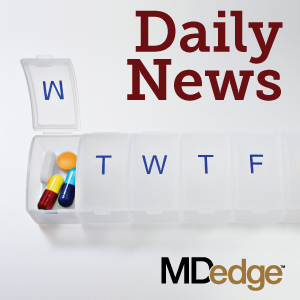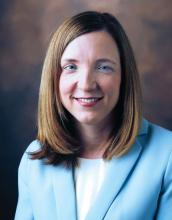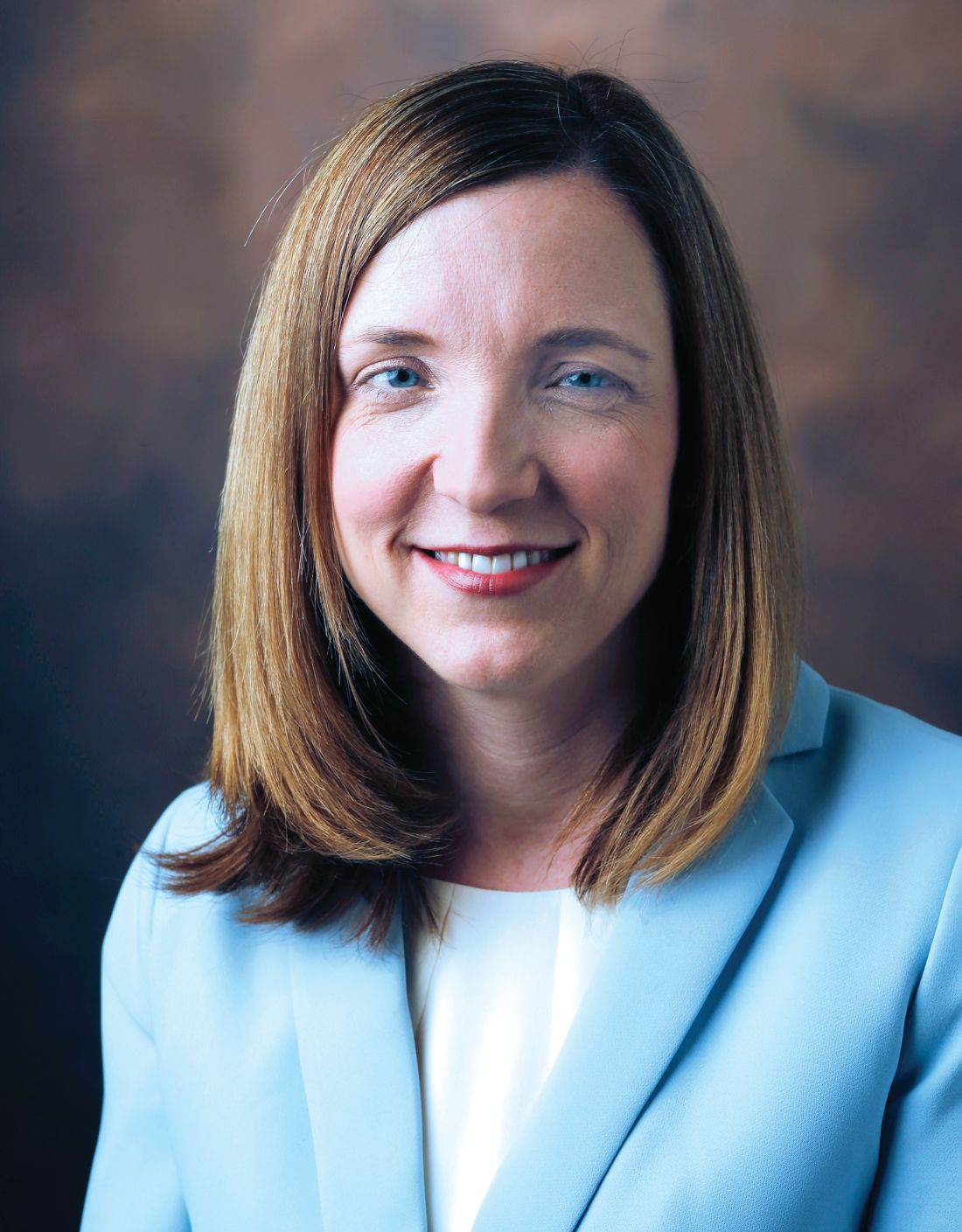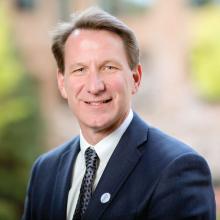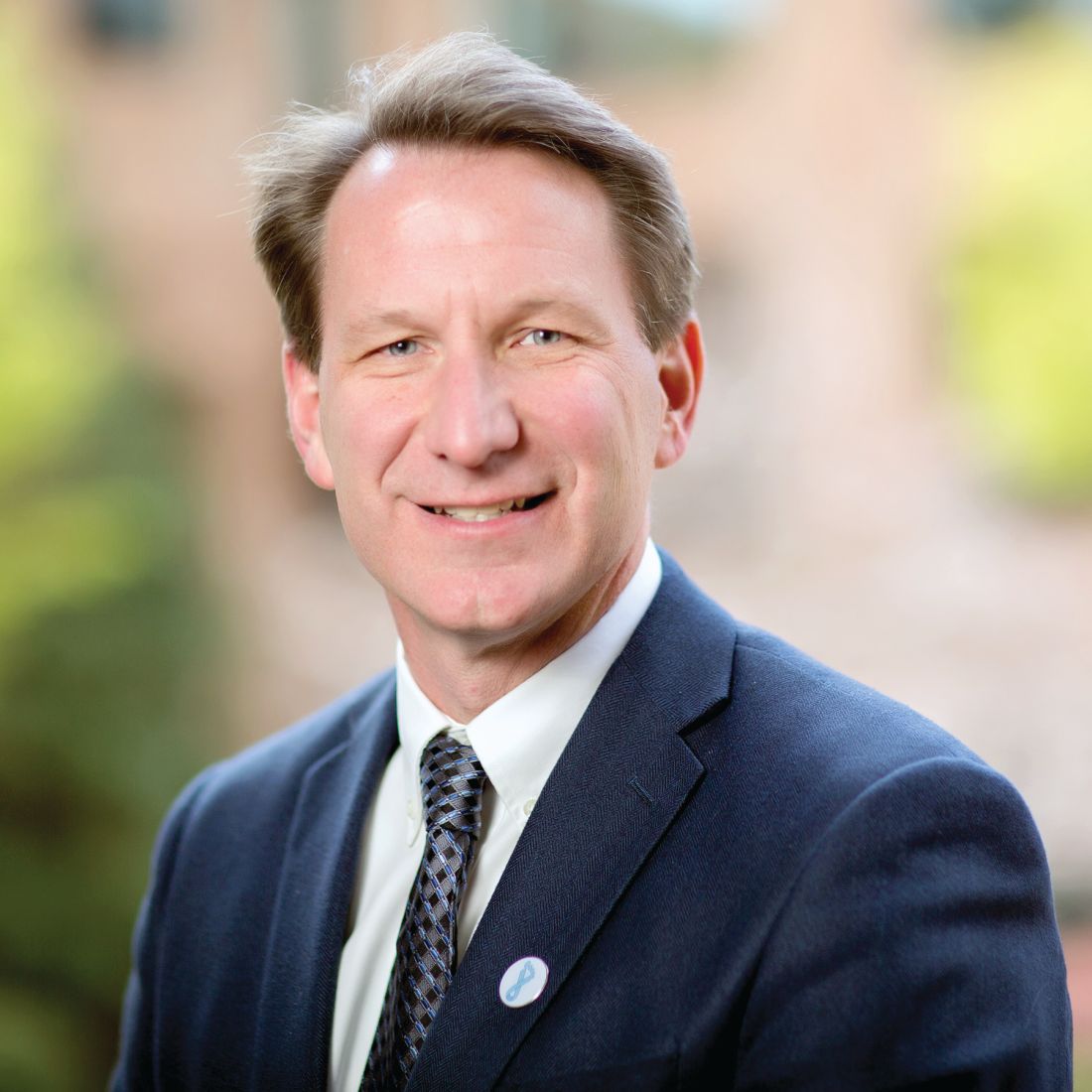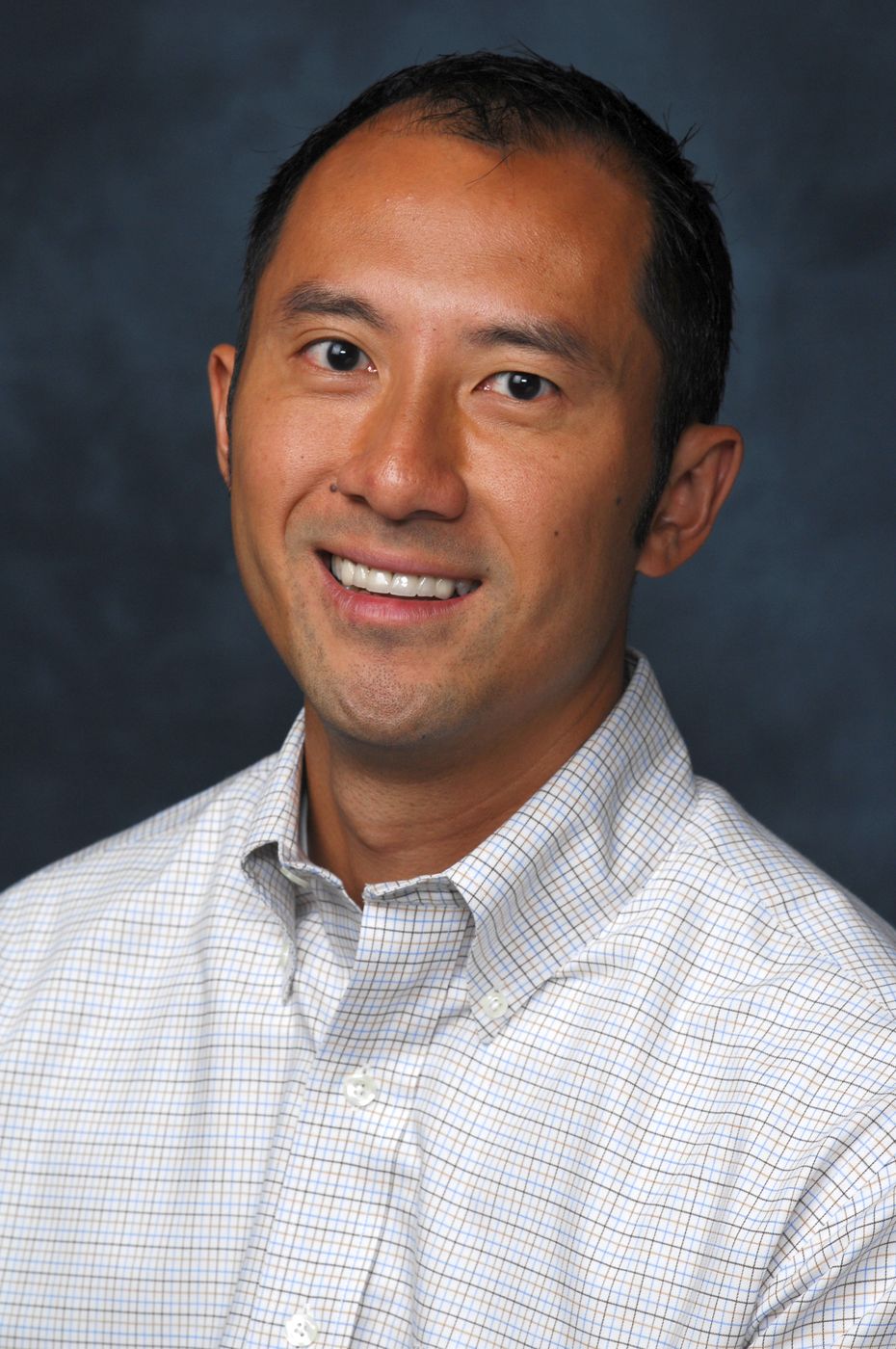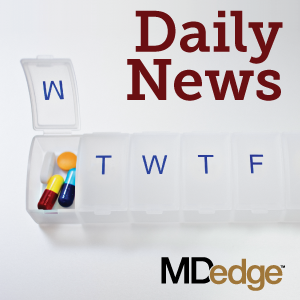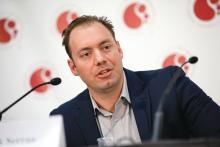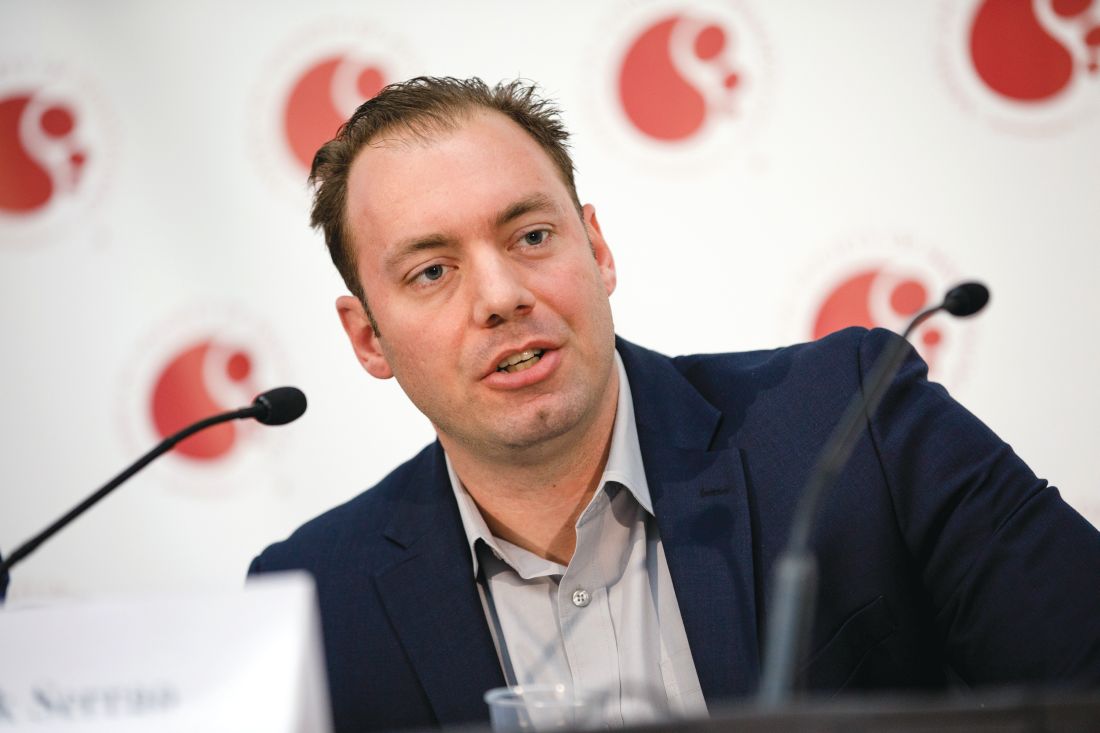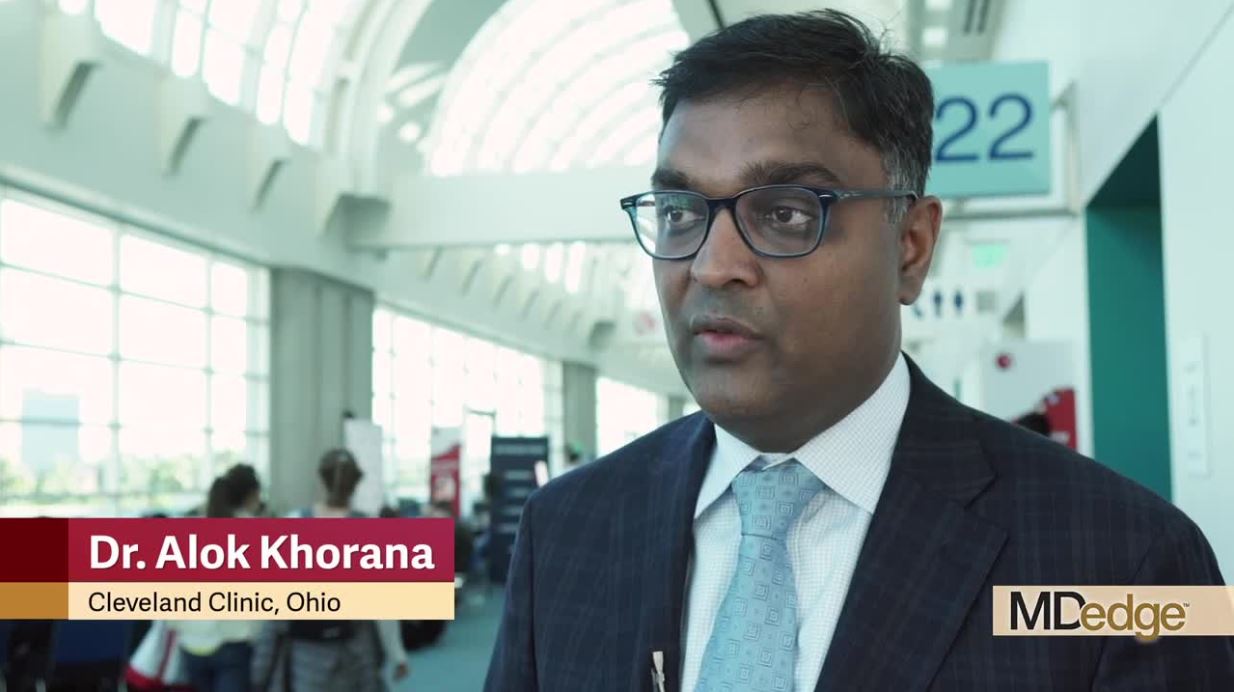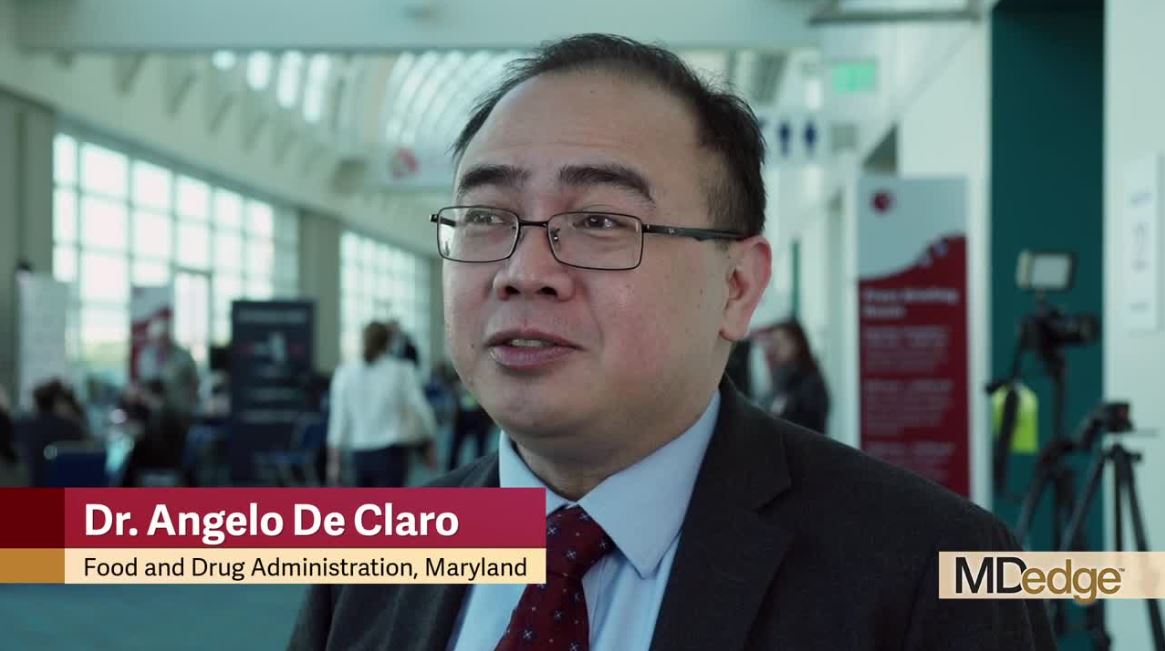User login
Parental leave for residents
Also today, exercise is important for patients with sickle cell, COPD patients are experiencing a risk in non-TB mycobacteria infections, and how to be an influencer on social media.
Amazon Alexa
Apple Podcasts
Google Podcasts
Spotify
Also today, exercise is important for patients with sickle cell, COPD patients are experiencing a risk in non-TB mycobacteria infections, and how to be an influencer on social media.
Amazon Alexa
Apple Podcasts
Google Podcasts
Spotify
Also today, exercise is important for patients with sickle cell, COPD patients are experiencing a risk in non-TB mycobacteria infections, and how to be an influencer on social media.
Amazon Alexa
Apple Podcasts
Google Podcasts
Spotify
Brain injury in sickle cell merits more attention
BETHESDA, MD. – The risk of brain damage from sickle cell disease (SCD) merits more attention, even with progress made in recent decades to prevent strokes, according to Lori Jordan, MD, PhD, of Vanderbilt University, Nashville, Tenn.
“Whether we can see it or not, the same injury we’ve been talking about in the kidney and the liver and other places is occurring in the brain” with sickle cell disease, Dr. Jordan said at Sickle Cell in Focus, a conference held by the National Institutes of Health.
The concern about long-term brain injury reflects major shifts in SCD treatment. Improved medical care has transformed SCD from a disease that often resulted in an early death to more of a chronic condition, Dr. Jordan said, citing research that shows a survival rate of roughly 99% to age 18 years (Br J Haematol. 2016 Jun;173[6]:927-37).
One of the major success stories in SCD treatment also has been using primary prevention steps to cut the risk of overt stroke at least 10-fold, Dr. Jordan said. Primary prevention includes annual scans with transcranial Doppler ultrasound to identify children with SCD at high risk of stroke.
“What’s not changing is that there is silent injury that accumulates” and can cause lifelong harm, she said. “We want to protect our patients long term so that they can have a successful adult life, not just a successful childhood.”
Research done by one of Dr. Jordan’s colleagues at Vanderbilt, Michael R. DeBaun, MD, showed that regular blood-transfusion therapy significantly reduced the incidence of the recurrence of brain infarct in children with sickle cell anemia. (N Engl J Med. 2014 Aug 21;371[8]:699-710).
But the lessons from the work of Dr. DeBaun and his colleagues with their Silent Cerebral Infarct Multi-Center Clinical (SIT) Trial have not yet been fully adopted, Dr. Jordan said. That’s partly due to the inconvenience and cost of routinely administered blood transfusions to prevent silent cerebral infarcts, which, when used long term, cause side effects, she said.
Dr. Jordan said there’s growing interest in identifying patients at high risk for stroke and moving them toward stem cell transplant, though studies are ongoing. She urged greater attention to the high lifetime costs of strokes and other cerebrovascular complications, particularly in children and young adults.
While some of the brain infarcts are small and don’t result in focal weakness of the body, these “silent infarcts” do produce cognitive effects that reduce function, school performance, employment, and quality of life, she said.
“The injury to the brain is present, whether we can see it or not,” Dr. Jordan said. “In these precious patients, slow cognitive decline isn’t acceptable, frankly.”
Dr. Jordan reported having received funding from the American Heart Association and the National Institutes of Health for stroke prevention studies in SCD.
BETHESDA, MD. – The risk of brain damage from sickle cell disease (SCD) merits more attention, even with progress made in recent decades to prevent strokes, according to Lori Jordan, MD, PhD, of Vanderbilt University, Nashville, Tenn.
“Whether we can see it or not, the same injury we’ve been talking about in the kidney and the liver and other places is occurring in the brain” with sickle cell disease, Dr. Jordan said at Sickle Cell in Focus, a conference held by the National Institutes of Health.
The concern about long-term brain injury reflects major shifts in SCD treatment. Improved medical care has transformed SCD from a disease that often resulted in an early death to more of a chronic condition, Dr. Jordan said, citing research that shows a survival rate of roughly 99% to age 18 years (Br J Haematol. 2016 Jun;173[6]:927-37).
One of the major success stories in SCD treatment also has been using primary prevention steps to cut the risk of overt stroke at least 10-fold, Dr. Jordan said. Primary prevention includes annual scans with transcranial Doppler ultrasound to identify children with SCD at high risk of stroke.
“What’s not changing is that there is silent injury that accumulates” and can cause lifelong harm, she said. “We want to protect our patients long term so that they can have a successful adult life, not just a successful childhood.”
Research done by one of Dr. Jordan’s colleagues at Vanderbilt, Michael R. DeBaun, MD, showed that regular blood-transfusion therapy significantly reduced the incidence of the recurrence of brain infarct in children with sickle cell anemia. (N Engl J Med. 2014 Aug 21;371[8]:699-710).
But the lessons from the work of Dr. DeBaun and his colleagues with their Silent Cerebral Infarct Multi-Center Clinical (SIT) Trial have not yet been fully adopted, Dr. Jordan said. That’s partly due to the inconvenience and cost of routinely administered blood transfusions to prevent silent cerebral infarcts, which, when used long term, cause side effects, she said.
Dr. Jordan said there’s growing interest in identifying patients at high risk for stroke and moving them toward stem cell transplant, though studies are ongoing. She urged greater attention to the high lifetime costs of strokes and other cerebrovascular complications, particularly in children and young adults.
While some of the brain infarcts are small and don’t result in focal weakness of the body, these “silent infarcts” do produce cognitive effects that reduce function, school performance, employment, and quality of life, she said.
“The injury to the brain is present, whether we can see it or not,” Dr. Jordan said. “In these precious patients, slow cognitive decline isn’t acceptable, frankly.”
Dr. Jordan reported having received funding from the American Heart Association and the National Institutes of Health for stroke prevention studies in SCD.
BETHESDA, MD. – The risk of brain damage from sickle cell disease (SCD) merits more attention, even with progress made in recent decades to prevent strokes, according to Lori Jordan, MD, PhD, of Vanderbilt University, Nashville, Tenn.
“Whether we can see it or not, the same injury we’ve been talking about in the kidney and the liver and other places is occurring in the brain” with sickle cell disease, Dr. Jordan said at Sickle Cell in Focus, a conference held by the National Institutes of Health.
The concern about long-term brain injury reflects major shifts in SCD treatment. Improved medical care has transformed SCD from a disease that often resulted in an early death to more of a chronic condition, Dr. Jordan said, citing research that shows a survival rate of roughly 99% to age 18 years (Br J Haematol. 2016 Jun;173[6]:927-37).
One of the major success stories in SCD treatment also has been using primary prevention steps to cut the risk of overt stroke at least 10-fold, Dr. Jordan said. Primary prevention includes annual scans with transcranial Doppler ultrasound to identify children with SCD at high risk of stroke.
“What’s not changing is that there is silent injury that accumulates” and can cause lifelong harm, she said. “We want to protect our patients long term so that they can have a successful adult life, not just a successful childhood.”
Research done by one of Dr. Jordan’s colleagues at Vanderbilt, Michael R. DeBaun, MD, showed that regular blood-transfusion therapy significantly reduced the incidence of the recurrence of brain infarct in children with sickle cell anemia. (N Engl J Med. 2014 Aug 21;371[8]:699-710).
But the lessons from the work of Dr. DeBaun and his colleagues with their Silent Cerebral Infarct Multi-Center Clinical (SIT) Trial have not yet been fully adopted, Dr. Jordan said. That’s partly due to the inconvenience and cost of routinely administered blood transfusions to prevent silent cerebral infarcts, which, when used long term, cause side effects, she said.
Dr. Jordan said there’s growing interest in identifying patients at high risk for stroke and moving them toward stem cell transplant, though studies are ongoing. She urged greater attention to the high lifetime costs of strokes and other cerebrovascular complications, particularly in children and young adults.
While some of the brain infarcts are small and don’t result in focal weakness of the body, these “silent infarcts” do produce cognitive effects that reduce function, school performance, employment, and quality of life, she said.
“The injury to the brain is present, whether we can see it or not,” Dr. Jordan said. “In these precious patients, slow cognitive decline isn’t acceptable, frankly.”
Dr. Jordan reported having received funding from the American Heart Association and the National Institutes of Health for stroke prevention studies in SCD.
EXPERT ANALYSIS FROM SICKLE CELL IN FOCUS
NCI director: Data failures cost lives
SAN DIEGO – A couple years ago, hematologist-oncologist Norman E. “Ned” Sharpless, MD, was gobsmacked by a groundbreaking study into treatments for acute myeloid leukemia. While the findings offered valuable new insight into the best drug options, they left Dr. Sharpless quaking, and not with delight. “I can recall that my knees buckled,” he said.
Why? Because the findings, he told colleagues at the annual meeting of the American Society of Hematology, came too late for many patients to benefit. “One could say that’s great news, this is medical progress,” he said. “But I saw this as a clear failure of data aggregation.”
Now, Dr. Sharpless is in a position to do more than fume and speak out. He became the director of the National Cancer Institute in 2017 and he’s made “big data” one of his four priorities for the NCI under his leadership.
“While data security is crucial, there are also costs to not aggregating data and sharing it,” he said. “It means giving patients the wrong drug, it means patients having to die.”
While Dr. Sharpless said he’s disappointed by the progress on data in medicine, he had praise to offer, too. In conversations over his first year-plus on the job, he said, he’s learned that “it’s a great time to be a cancer scientist and a cancer doctor in the United States. ... It’s undeniably a great time to be a blood doctor or blood scientist. We’re making progress at a rate that is faster and greater than at any point in my career as an oncologist. Just look at all the new stuff we’ve got!”
In hematology, great strides are being made in areas such as the treatment of leukemia and lymphoma, he said. Progress is also boosting treatment in areas such as melanoma and lung, breast, ovarian, and head and neck cancer.
“Some of you will correctly point out that this progress is not enough. In some cases, treatments are moderately effective and not curative. These are singles or even doubles, but we still need home runs. We still have too many patients dying of cancer, including blood cancer,” he said. “From my perspective, it’s important to be very clear-eyed. While we have a long way to go to end suffering in all patients, we have to be willing to admit that progress has been impressive.”
Dr. Sharpless touted the Cancer Moonshot, which will allocate $1.8 billion in federal funds for cancer research over 7 years. And he mentioned his four priority areas at NCI: Workforce development, basic science, big data, and clinical trials. Initiatives in these areas include prioritization of research by early-career investigators and increased funding for trials, he said.
As for data, he said, “I’ve been trying to explain to congressional leaders why getting control of our data is important.”
Dr. Sharpless likes to point to his own encounter in his kitchen in 2016 – the one that buckled his knees – with an issue of the New England Journal of Medicine. There he found a study that examined molecular determinants of response to decitabine in acute myeloid leukemia and myelodysplastic syndromes (N Engl J Med. 2016 Nov 24;375[21]:2023-36).
“I can still close my eyes now and literally see the faces of patients whom I gave ... a very toxic regimen, some of whom had very bad outcomes,” he said. “I know in retrospect, based on certain statistics, I probably used the wrong drug in some of these patients. If we’d been aggregating data in a deliberate way, from the get-go of AML, a result like this would have fallen out immediately. I’m concerned we’re still making these types of mistakes for other cancer subtypes today.”
Moving forward, he said, the goal is “to create large, multimodal data sets ... And put them in the cloud and make them available to the research community in the most useful format possible, in a way that’s safe and secure. We have to do these things because the costs of not harnessing data are too great.”
Dr. Sharpless reported several past financial relationships with G1 Therapeutics, Healthspan Diagnostics, and Unity Biotechnology.
SAN DIEGO – A couple years ago, hematologist-oncologist Norman E. “Ned” Sharpless, MD, was gobsmacked by a groundbreaking study into treatments for acute myeloid leukemia. While the findings offered valuable new insight into the best drug options, they left Dr. Sharpless quaking, and not with delight. “I can recall that my knees buckled,” he said.
Why? Because the findings, he told colleagues at the annual meeting of the American Society of Hematology, came too late for many patients to benefit. “One could say that’s great news, this is medical progress,” he said. “But I saw this as a clear failure of data aggregation.”
Now, Dr. Sharpless is in a position to do more than fume and speak out. He became the director of the National Cancer Institute in 2017 and he’s made “big data” one of his four priorities for the NCI under his leadership.
“While data security is crucial, there are also costs to not aggregating data and sharing it,” he said. “It means giving patients the wrong drug, it means patients having to die.”
While Dr. Sharpless said he’s disappointed by the progress on data in medicine, he had praise to offer, too. In conversations over his first year-plus on the job, he said, he’s learned that “it’s a great time to be a cancer scientist and a cancer doctor in the United States. ... It’s undeniably a great time to be a blood doctor or blood scientist. We’re making progress at a rate that is faster and greater than at any point in my career as an oncologist. Just look at all the new stuff we’ve got!”
In hematology, great strides are being made in areas such as the treatment of leukemia and lymphoma, he said. Progress is also boosting treatment in areas such as melanoma and lung, breast, ovarian, and head and neck cancer.
“Some of you will correctly point out that this progress is not enough. In some cases, treatments are moderately effective and not curative. These are singles or even doubles, but we still need home runs. We still have too many patients dying of cancer, including blood cancer,” he said. “From my perspective, it’s important to be very clear-eyed. While we have a long way to go to end suffering in all patients, we have to be willing to admit that progress has been impressive.”
Dr. Sharpless touted the Cancer Moonshot, which will allocate $1.8 billion in federal funds for cancer research over 7 years. And he mentioned his four priority areas at NCI: Workforce development, basic science, big data, and clinical trials. Initiatives in these areas include prioritization of research by early-career investigators and increased funding for trials, he said.
As for data, he said, “I’ve been trying to explain to congressional leaders why getting control of our data is important.”
Dr. Sharpless likes to point to his own encounter in his kitchen in 2016 – the one that buckled his knees – with an issue of the New England Journal of Medicine. There he found a study that examined molecular determinants of response to decitabine in acute myeloid leukemia and myelodysplastic syndromes (N Engl J Med. 2016 Nov 24;375[21]:2023-36).
“I can still close my eyes now and literally see the faces of patients whom I gave ... a very toxic regimen, some of whom had very bad outcomes,” he said. “I know in retrospect, based on certain statistics, I probably used the wrong drug in some of these patients. If we’d been aggregating data in a deliberate way, from the get-go of AML, a result like this would have fallen out immediately. I’m concerned we’re still making these types of mistakes for other cancer subtypes today.”
Moving forward, he said, the goal is “to create large, multimodal data sets ... And put them in the cloud and make them available to the research community in the most useful format possible, in a way that’s safe and secure. We have to do these things because the costs of not harnessing data are too great.”
Dr. Sharpless reported several past financial relationships with G1 Therapeutics, Healthspan Diagnostics, and Unity Biotechnology.
SAN DIEGO – A couple years ago, hematologist-oncologist Norman E. “Ned” Sharpless, MD, was gobsmacked by a groundbreaking study into treatments for acute myeloid leukemia. While the findings offered valuable new insight into the best drug options, they left Dr. Sharpless quaking, and not with delight. “I can recall that my knees buckled,” he said.
Why? Because the findings, he told colleagues at the annual meeting of the American Society of Hematology, came too late for many patients to benefit. “One could say that’s great news, this is medical progress,” he said. “But I saw this as a clear failure of data aggregation.”
Now, Dr. Sharpless is in a position to do more than fume and speak out. He became the director of the National Cancer Institute in 2017 and he’s made “big data” one of his four priorities for the NCI under his leadership.
“While data security is crucial, there are also costs to not aggregating data and sharing it,” he said. “It means giving patients the wrong drug, it means patients having to die.”
While Dr. Sharpless said he’s disappointed by the progress on data in medicine, he had praise to offer, too. In conversations over his first year-plus on the job, he said, he’s learned that “it’s a great time to be a cancer scientist and a cancer doctor in the United States. ... It’s undeniably a great time to be a blood doctor or blood scientist. We’re making progress at a rate that is faster and greater than at any point in my career as an oncologist. Just look at all the new stuff we’ve got!”
In hematology, great strides are being made in areas such as the treatment of leukemia and lymphoma, he said. Progress is also boosting treatment in areas such as melanoma and lung, breast, ovarian, and head and neck cancer.
“Some of you will correctly point out that this progress is not enough. In some cases, treatments are moderately effective and not curative. These are singles or even doubles, but we still need home runs. We still have too many patients dying of cancer, including blood cancer,” he said. “From my perspective, it’s important to be very clear-eyed. While we have a long way to go to end suffering in all patients, we have to be willing to admit that progress has been impressive.”
Dr. Sharpless touted the Cancer Moonshot, which will allocate $1.8 billion in federal funds for cancer research over 7 years. And he mentioned his four priority areas at NCI: Workforce development, basic science, big data, and clinical trials. Initiatives in these areas include prioritization of research by early-career investigators and increased funding for trials, he said.
As for data, he said, “I’ve been trying to explain to congressional leaders why getting control of our data is important.”
Dr. Sharpless likes to point to his own encounter in his kitchen in 2016 – the one that buckled his knees – with an issue of the New England Journal of Medicine. There he found a study that examined molecular determinants of response to decitabine in acute myeloid leukemia and myelodysplastic syndromes (N Engl J Med. 2016 Nov 24;375[21]:2023-36).
“I can still close my eyes now and literally see the faces of patients whom I gave ... a very toxic regimen, some of whom had very bad outcomes,” he said. “I know in retrospect, based on certain statistics, I probably used the wrong drug in some of these patients. If we’d been aggregating data in a deliberate way, from the get-go of AML, a result like this would have fallen out immediately. I’m concerned we’re still making these types of mistakes for other cancer subtypes today.”
Moving forward, he said, the goal is “to create large, multimodal data sets ... And put them in the cloud and make them available to the research community in the most useful format possible, in a way that’s safe and secure. We have to do these things because the costs of not harnessing data are too great.”
Dr. Sharpless reported several past financial relationships with G1 Therapeutics, Healthspan Diagnostics, and Unity Biotechnology.
REPORTING FROM ASH 2018
Despite risks, exercise is important for patients with sickle cell
SAN DIEGO – Don’t let all your patients with sickle cell anemia (SCA) and sickle cell trait (SCT) off the hook when it comes to exercise. That was the advice from Robert I. Liem, MD, a pediatric hematologist-oncologist who studies fitness.
While some patients may face risk, these conditions should pose less of a barrier to moderate- and even high-intensity exercise, Dr. Liem, of Ann & Robert H. Lurie Children’s Hospital of Chicago and Northwestern University, Chicago, said at the annual meeting of the American Society of Hematology.
“Instead of just focusing on potential harms, we should consider a paradigm shift, especially in sickle cell anemia,” he said. “There, we can start to consider the benefits of exercise, which may include some disease-modifying effects.”
There have been no formal studies into whether high-intensity exercise poses harm in patients with SCA, Dr. Liem noted. Why? There are several reasons, he said, including concern that exercise could increase sickling of red blood cells and assumptions about “sedentary behavior” in SCA.
However, there are indications that factors other than SCA may be reducing fitness in this population, a fact that could potentially be reversed by exercise.
Dr. Liem led a study that found “children and young adults with SCA have reduced exercise capacity attributable to factors independent of anemia.” The study showed that peak VO2 was 30% lower in children and young adults with SCA, compared with controls (Physiol Rep. 2015. doi: 10.14814/phy2.12338).
There are many possible explanations for this, he said, including patient-related factors such as pain during exercise and poor access to fitness resources.
Another study found low fitness in 83% of adults with SCA and identified chronic anemia as the most important factor (Am J Hematol. 2014 Aug;89[8]:819-24).
In patients with sickle cell trait, which Dr. Liem said affects an estimated 6%-9% of African-Americans, early reports of sudden death appeared in the 1960s and 1970s, and recent studies have provided more insight into the risk.
In 2012, a study tracked NCAA student athletes and found that Division I football players with SCT faced a 37-fold higher risk of exertion-related death than did athletes without SCT. Five players with SCT, all black and all Division I football players, had died over a 5-year period (Br J Sports Med 2012 Apr;46[5]:325-30).
A 2016 study, meanwhile, tracked more than 47,000 black soldiers in the U.S. Army and found those with SCT didn’t face a higher risk of death although they did have a “significantly higher risk” of exertional rhabdomyolysis (N Engl J Med. 2016 Aug 4; 375[5]:435-42).
While the cause of exercise-related harm in SCT isn’t fully understood, Dr. Liem said, it’s possible that extreme states such as severe dehydration, acidosis, and hypoxemia may trigger sickling. A combination of SCT, extreme exercise, heat, and genetic predisposition could produce harm by creating a “perfect storm,” he added.
Should patients with SCA or SCT exercise? Yes, Dr. Liem said, pointing to the importance of fitness in the general population.
Exercising to volitional exhaustion appears to be safe in children and adults with SCA, he said, and lack of exercise could lead to a variety of negative effects on growth in children and on quality of life.
There are “limited but promising data” linking exercise to benefits in SCA and SCT populations, he said.
Moving forward, Dr. Liem noted that guidelines from the NCAA and National Athletic Trainers’ Association offer insight into exercise best practices in SCT. They’re designed to promote acclimation during training, access to fluids, and prompt recognition of symptoms of heat-related illness and a condition known as “exercise collapse associated with sickle trait.”
However, there are no guidelines for exercise in SCA and it’s not helpful to let patients set limits on themselves based on the symptoms they experience, he said.
Dr. Liem reported having no relevant financial disclosures.
SAN DIEGO – Don’t let all your patients with sickle cell anemia (SCA) and sickle cell trait (SCT) off the hook when it comes to exercise. That was the advice from Robert I. Liem, MD, a pediatric hematologist-oncologist who studies fitness.
While some patients may face risk, these conditions should pose less of a barrier to moderate- and even high-intensity exercise, Dr. Liem, of Ann & Robert H. Lurie Children’s Hospital of Chicago and Northwestern University, Chicago, said at the annual meeting of the American Society of Hematology.
“Instead of just focusing on potential harms, we should consider a paradigm shift, especially in sickle cell anemia,” he said. “There, we can start to consider the benefits of exercise, which may include some disease-modifying effects.”
There have been no formal studies into whether high-intensity exercise poses harm in patients with SCA, Dr. Liem noted. Why? There are several reasons, he said, including concern that exercise could increase sickling of red blood cells and assumptions about “sedentary behavior” in SCA.
However, there are indications that factors other than SCA may be reducing fitness in this population, a fact that could potentially be reversed by exercise.
Dr. Liem led a study that found “children and young adults with SCA have reduced exercise capacity attributable to factors independent of anemia.” The study showed that peak VO2 was 30% lower in children and young adults with SCA, compared with controls (Physiol Rep. 2015. doi: 10.14814/phy2.12338).
There are many possible explanations for this, he said, including patient-related factors such as pain during exercise and poor access to fitness resources.
Another study found low fitness in 83% of adults with SCA and identified chronic anemia as the most important factor (Am J Hematol. 2014 Aug;89[8]:819-24).
In patients with sickle cell trait, which Dr. Liem said affects an estimated 6%-9% of African-Americans, early reports of sudden death appeared in the 1960s and 1970s, and recent studies have provided more insight into the risk.
In 2012, a study tracked NCAA student athletes and found that Division I football players with SCT faced a 37-fold higher risk of exertion-related death than did athletes without SCT. Five players with SCT, all black and all Division I football players, had died over a 5-year period (Br J Sports Med 2012 Apr;46[5]:325-30).
A 2016 study, meanwhile, tracked more than 47,000 black soldiers in the U.S. Army and found those with SCT didn’t face a higher risk of death although they did have a “significantly higher risk” of exertional rhabdomyolysis (N Engl J Med. 2016 Aug 4; 375[5]:435-42).
While the cause of exercise-related harm in SCT isn’t fully understood, Dr. Liem said, it’s possible that extreme states such as severe dehydration, acidosis, and hypoxemia may trigger sickling. A combination of SCT, extreme exercise, heat, and genetic predisposition could produce harm by creating a “perfect storm,” he added.
Should patients with SCA or SCT exercise? Yes, Dr. Liem said, pointing to the importance of fitness in the general population.
Exercising to volitional exhaustion appears to be safe in children and adults with SCA, he said, and lack of exercise could lead to a variety of negative effects on growth in children and on quality of life.
There are “limited but promising data” linking exercise to benefits in SCA and SCT populations, he said.
Moving forward, Dr. Liem noted that guidelines from the NCAA and National Athletic Trainers’ Association offer insight into exercise best practices in SCT. They’re designed to promote acclimation during training, access to fluids, and prompt recognition of symptoms of heat-related illness and a condition known as “exercise collapse associated with sickle trait.”
However, there are no guidelines for exercise in SCA and it’s not helpful to let patients set limits on themselves based on the symptoms they experience, he said.
Dr. Liem reported having no relevant financial disclosures.
SAN DIEGO – Don’t let all your patients with sickle cell anemia (SCA) and sickle cell trait (SCT) off the hook when it comes to exercise. That was the advice from Robert I. Liem, MD, a pediatric hematologist-oncologist who studies fitness.
While some patients may face risk, these conditions should pose less of a barrier to moderate- and even high-intensity exercise, Dr. Liem, of Ann & Robert H. Lurie Children’s Hospital of Chicago and Northwestern University, Chicago, said at the annual meeting of the American Society of Hematology.
“Instead of just focusing on potential harms, we should consider a paradigm shift, especially in sickle cell anemia,” he said. “There, we can start to consider the benefits of exercise, which may include some disease-modifying effects.”
There have been no formal studies into whether high-intensity exercise poses harm in patients with SCA, Dr. Liem noted. Why? There are several reasons, he said, including concern that exercise could increase sickling of red blood cells and assumptions about “sedentary behavior” in SCA.
However, there are indications that factors other than SCA may be reducing fitness in this population, a fact that could potentially be reversed by exercise.
Dr. Liem led a study that found “children and young adults with SCA have reduced exercise capacity attributable to factors independent of anemia.” The study showed that peak VO2 was 30% lower in children and young adults with SCA, compared with controls (Physiol Rep. 2015. doi: 10.14814/phy2.12338).
There are many possible explanations for this, he said, including patient-related factors such as pain during exercise and poor access to fitness resources.
Another study found low fitness in 83% of adults with SCA and identified chronic anemia as the most important factor (Am J Hematol. 2014 Aug;89[8]:819-24).
In patients with sickle cell trait, which Dr. Liem said affects an estimated 6%-9% of African-Americans, early reports of sudden death appeared in the 1960s and 1970s, and recent studies have provided more insight into the risk.
In 2012, a study tracked NCAA student athletes and found that Division I football players with SCT faced a 37-fold higher risk of exertion-related death than did athletes without SCT. Five players with SCT, all black and all Division I football players, had died over a 5-year period (Br J Sports Med 2012 Apr;46[5]:325-30).
A 2016 study, meanwhile, tracked more than 47,000 black soldiers in the U.S. Army and found those with SCT didn’t face a higher risk of death although they did have a “significantly higher risk” of exertional rhabdomyolysis (N Engl J Med. 2016 Aug 4; 375[5]:435-42).
While the cause of exercise-related harm in SCT isn’t fully understood, Dr. Liem said, it’s possible that extreme states such as severe dehydration, acidosis, and hypoxemia may trigger sickling. A combination of SCT, extreme exercise, heat, and genetic predisposition could produce harm by creating a “perfect storm,” he added.
Should patients with SCA or SCT exercise? Yes, Dr. Liem said, pointing to the importance of fitness in the general population.
Exercising to volitional exhaustion appears to be safe in children and adults with SCA, he said, and lack of exercise could lead to a variety of negative effects on growth in children and on quality of life.
There are “limited but promising data” linking exercise to benefits in SCA and SCT populations, he said.
Moving forward, Dr. Liem noted that guidelines from the NCAA and National Athletic Trainers’ Association offer insight into exercise best practices in SCT. They’re designed to promote acclimation during training, access to fluids, and prompt recognition of symptoms of heat-related illness and a condition known as “exercise collapse associated with sickle trait.”
However, there are no guidelines for exercise in SCA and it’s not helpful to let patients set limits on themselves based on the symptoms they experience, he said.
Dr. Liem reported having no relevant financial disclosures.
EXPERT ANALYSIS FROM ASH 2018
Tom Brokaw opens up on surviving multiple myeloma
SAN DIEGO – Tom Brokaw has devoted his life to openness and transparency. But he kept mum about a big story that only he could fully tell – his diagnosis of multiple myeloma. He alerted his bosses and a few loved ones but otherwise kept his condition secret even as he struggled to walk and navigate stairs.
“I didn’t want to be Tom Brokaw, cancer victim,” he said at the annual meeting of the American Society of Hematology. But he did decide to go public in a big way and he said he doesn’t regret it. “I’m kind of the multiple myeloma poster boy.”
Since opening up about myeloma, “I have learned more about life and medicine, and kindness and the extraordinary strength of this country, than I have in all my other experiences,” he said. “I can say, oddly enough, at age 78 about to be 79, that having multiple myeloma has been a kind of privilege for me.”
Mr. Brokaw is best known as the longtime anchor of “NBC Nightly News” and author of “The Greatest Generation,” about the American experience in World War II. He was diagnosed with multiple myeloma in 2013 and revealed his condition publicly in 2014.
In 2016, he described his treatment in a New York Times commentary: “...three years of chemotherapy, a spinal operation that cost me three inches of height, monthly infusions of bone supplements, and drugs to prevent respiratory infection.” He also described fatigue, bone damage, and a 24-pill-a-day regimen.
In his presentation at ASH, Mr. Brokaw detailed the adjustment of having to slow down after an active life as a cyclist and outdoorsman. “I’m not going to go down the street with a cane. My birth certificate says I’m 78 years old, but I still think I’m 38, anchoring the news.”
“There was so much concentration on the disease itself that I don’t think I got as much as I needed regarding the radiant effects.”
At one point, he fell while running with his dog, and developed an infection in a cavity in his elbow. Still, he refused to cancel a flight to Washington, D.C., for an interview with the secretary of defense. The infection got worse, soaking his shirt with leakage, and when he returned “they slammed me into intensive care.”
He got a stern instruction that “you can’t do this anymore,” and he responded with an “ohh-kay.”
“It’s the anchorman in me. You get used to doing what you want to do. But I have to be much more careful about what I do and when I do it,” he said.
Now, Mr. Brokaw still struggles to follow advice about risks such as flying. But he remains active as a speaker, a special correspondent for NBC, and an author. “By and large,” he said, “I’m getting along OK. I’m grateful for that.”
SAN DIEGO – Tom Brokaw has devoted his life to openness and transparency. But he kept mum about a big story that only he could fully tell – his diagnosis of multiple myeloma. He alerted his bosses and a few loved ones but otherwise kept his condition secret even as he struggled to walk and navigate stairs.
“I didn’t want to be Tom Brokaw, cancer victim,” he said at the annual meeting of the American Society of Hematology. But he did decide to go public in a big way and he said he doesn’t regret it. “I’m kind of the multiple myeloma poster boy.”
Since opening up about myeloma, “I have learned more about life and medicine, and kindness and the extraordinary strength of this country, than I have in all my other experiences,” he said. “I can say, oddly enough, at age 78 about to be 79, that having multiple myeloma has been a kind of privilege for me.”
Mr. Brokaw is best known as the longtime anchor of “NBC Nightly News” and author of “The Greatest Generation,” about the American experience in World War II. He was diagnosed with multiple myeloma in 2013 and revealed his condition publicly in 2014.
In 2016, he described his treatment in a New York Times commentary: “...three years of chemotherapy, a spinal operation that cost me three inches of height, monthly infusions of bone supplements, and drugs to prevent respiratory infection.” He also described fatigue, bone damage, and a 24-pill-a-day regimen.
In his presentation at ASH, Mr. Brokaw detailed the adjustment of having to slow down after an active life as a cyclist and outdoorsman. “I’m not going to go down the street with a cane. My birth certificate says I’m 78 years old, but I still think I’m 38, anchoring the news.”
“There was so much concentration on the disease itself that I don’t think I got as much as I needed regarding the radiant effects.”
At one point, he fell while running with his dog, and developed an infection in a cavity in his elbow. Still, he refused to cancel a flight to Washington, D.C., for an interview with the secretary of defense. The infection got worse, soaking his shirt with leakage, and when he returned “they slammed me into intensive care.”
He got a stern instruction that “you can’t do this anymore,” and he responded with an “ohh-kay.”
“It’s the anchorman in me. You get used to doing what you want to do. But I have to be much more careful about what I do and when I do it,” he said.
Now, Mr. Brokaw still struggles to follow advice about risks such as flying. But he remains active as a speaker, a special correspondent for NBC, and an author. “By and large,” he said, “I’m getting along OK. I’m grateful for that.”
SAN DIEGO – Tom Brokaw has devoted his life to openness and transparency. But he kept mum about a big story that only he could fully tell – his diagnosis of multiple myeloma. He alerted his bosses and a few loved ones but otherwise kept his condition secret even as he struggled to walk and navigate stairs.
“I didn’t want to be Tom Brokaw, cancer victim,” he said at the annual meeting of the American Society of Hematology. But he did decide to go public in a big way and he said he doesn’t regret it. “I’m kind of the multiple myeloma poster boy.”
Since opening up about myeloma, “I have learned more about life and medicine, and kindness and the extraordinary strength of this country, than I have in all my other experiences,” he said. “I can say, oddly enough, at age 78 about to be 79, that having multiple myeloma has been a kind of privilege for me.”
Mr. Brokaw is best known as the longtime anchor of “NBC Nightly News” and author of “The Greatest Generation,” about the American experience in World War II. He was diagnosed with multiple myeloma in 2013 and revealed his condition publicly in 2014.
In 2016, he described his treatment in a New York Times commentary: “...three years of chemotherapy, a spinal operation that cost me three inches of height, monthly infusions of bone supplements, and drugs to prevent respiratory infection.” He also described fatigue, bone damage, and a 24-pill-a-day regimen.
In his presentation at ASH, Mr. Brokaw detailed the adjustment of having to slow down after an active life as a cyclist and outdoorsman. “I’m not going to go down the street with a cane. My birth certificate says I’m 78 years old, but I still think I’m 38, anchoring the news.”
“There was so much concentration on the disease itself that I don’t think I got as much as I needed regarding the radiant effects.”
At one point, he fell while running with his dog, and developed an infection in a cavity in his elbow. Still, he refused to cancel a flight to Washington, D.C., for an interview with the secretary of defense. The infection got worse, soaking his shirt with leakage, and when he returned “they slammed me into intensive care.”
He got a stern instruction that “you can’t do this anymore,” and he responded with an “ohh-kay.”
“It’s the anchorman in me. You get used to doing what you want to do. But I have to be much more careful about what I do and when I do it,” he said.
Now, Mr. Brokaw still struggles to follow advice about risks such as flying. But he remains active as a speaker, a special correspondent for NBC, and an author. “By and large,” he said, “I’m getting along OK. I’m grateful for that.”
EXPERT ANALYSIS FROM ASH 2018
ASH 2018 meeting wrap-up
In this special meetings edition of the MDedge Daily News we hear from Dr. Arok Khorana of the Cleveland Clinic on rivaroxaban for the prevention of VTE in cancer patients. We also hear from Dr. Ify Osunkwo of the Levine Cancer Institute on recent advances in sickle cell disease.
Amazon Alexa
Apple Podcasts
Google Podcasts
Spotify
In this special meetings edition of the MDedge Daily News we hear from Dr. Arok Khorana of the Cleveland Clinic on rivaroxaban for the prevention of VTE in cancer patients. We also hear from Dr. Ify Osunkwo of the Levine Cancer Institute on recent advances in sickle cell disease.
Amazon Alexa
Apple Podcasts
Google Podcasts
Spotify
In this special meetings edition of the MDedge Daily News we hear from Dr. Arok Khorana of the Cleveland Clinic on rivaroxaban for the prevention of VTE in cancer patients. We also hear from Dr. Ify Osunkwo of the Levine Cancer Institute on recent advances in sickle cell disease.
Amazon Alexa
Apple Podcasts
Google Podcasts
Spotify
Rapid test could solve Africa’s sickle cell screening problem
SAN DIEGO – An inexpensive, rapid, and easy-to-use blood test was more than 99% accurate in detecting sickle cell disease in young children in sub-Saharan Africa, according to research reported at the annual meeting of the American Society of Hematology.
The test, called HemoTypeSC, uses monoclonal antibodies to detect hemoglobins A, S, and C in a drop of whole blood, said investigator Erik Serrao, PhD, of Silver Lake Research in Azusa, Calif.
Findings from the diagnostic accuracy trial, which included 1,000 children in Uganda, suggest that the immunoassay is a promising tool to enable newborn and general population screening in resource-constrained regions of high prevalence, such as Africa and India.
“Early screening plus treatment plus counseling equals saving millions of lives over the coming decades, and we believe HemoTypeSC can form an integral part of the initial part of this equation,” Dr. Serrao said during a late-breaking abstract session at the meeting.
Each test kit costs less than $2 to the end user; requires no electricity, special equipment, or training; and delivers results in about 10 minutes, he added.
Of all the late-breaking abstracts at ASH this year, the study by Dr. Serrao and his colleagues is the one with the potential to save the most lives, said Mark Crowther, MD, of McMaster University, Hamilton, Ont.
“The ability to diagnose sickle cell disease early and intervene early will result in potentially thousands of infants, who would otherwise die in infancy or early childhood, surviving into adulthood,” Dr. Crowther said during a press briefing.
Using current gold standard methods for diagnosing sickle cell disease is, at minimum, challenging and “frankly impossible” in many low-resource settings, because of the cost and the requirement for sophisticated equipment and reliable electricity, Dr. Crowther added.
In the study, investigators compared results of the HemoTypeSC test with hemoglobin electrophoresis for detection of the phenotypes HbAA (normal), HbAS (sickle cell trait), and HbSS (sickle cell disease). They compared these two testing methods in 1,000 children between the ages of 1 month and 5 years who were prospectively recruited from hospital wards and outpatient clinics in Uganda.
The immunoassay had an overall accuracy of 99.8%, correctly identifying 998 of 1,000 phenotypes as initially determined by electrophoresis. Specifically, the test correctly identified 100% of the 720 HbAA specimens, 100% of 182 HbAS specimens, and 98% of HbSS, or 96 of 98 specimens, leaving just 2 discordant samples, both of which HemoTypeSC identified as HbAS.
Investigators subsequently discovered that both of the individuals with the discordant samples had previously been diagnosed with sickle cell disease and had received recent transfusions. Both cases were subsequently confirmed as HbSS in review of previous diagnostic result reports, bringing the accuracy rate up to 100% in a secondary analysis also reported at the meeting.
Although this particular study excluded newborns, a different study of the immunoassay, recently published in the American Journal of Hematology, demonstrated 100% accuracy across multiple phenotypes in the setting of newborn screening (2018 Oct 5. doi: 10.1002/ajh.25305).
Sickle cell disease screening programs have been projected to be cost effective in Africa, Dr. Serrano said, and could even save money for governments over time as budgets are reallocated toward screening, with less money needed for treatment of patients presenting with severe complications in hospitals.
Dr. Serrao reported that he is an employee of Silver Lake Research, which funded the study, approved the study design, and donated HemoTypeSC tests.
On March 11, 2019, the editors of Blood, an ASH journal, retracted the abstract for this study. The second listed author on the abstract said that it was submitted without his consent or approval. The retraction makes no statement on the underlying science of the study, the editors noted.
This article was updated on 3/14/2019.
SOURCE: Serrao E et al. ASH 2018, Abstract LBA-3.
SAN DIEGO – An inexpensive, rapid, and easy-to-use blood test was more than 99% accurate in detecting sickle cell disease in young children in sub-Saharan Africa, according to research reported at the annual meeting of the American Society of Hematology.
The test, called HemoTypeSC, uses monoclonal antibodies to detect hemoglobins A, S, and C in a drop of whole blood, said investigator Erik Serrao, PhD, of Silver Lake Research in Azusa, Calif.
Findings from the diagnostic accuracy trial, which included 1,000 children in Uganda, suggest that the immunoassay is a promising tool to enable newborn and general population screening in resource-constrained regions of high prevalence, such as Africa and India.
“Early screening plus treatment plus counseling equals saving millions of lives over the coming decades, and we believe HemoTypeSC can form an integral part of the initial part of this equation,” Dr. Serrao said during a late-breaking abstract session at the meeting.
Each test kit costs less than $2 to the end user; requires no electricity, special equipment, or training; and delivers results in about 10 minutes, he added.
Of all the late-breaking abstracts at ASH this year, the study by Dr. Serrao and his colleagues is the one with the potential to save the most lives, said Mark Crowther, MD, of McMaster University, Hamilton, Ont.
“The ability to diagnose sickle cell disease early and intervene early will result in potentially thousands of infants, who would otherwise die in infancy or early childhood, surviving into adulthood,” Dr. Crowther said during a press briefing.
Using current gold standard methods for diagnosing sickle cell disease is, at minimum, challenging and “frankly impossible” in many low-resource settings, because of the cost and the requirement for sophisticated equipment and reliable electricity, Dr. Crowther added.
In the study, investigators compared results of the HemoTypeSC test with hemoglobin electrophoresis for detection of the phenotypes HbAA (normal), HbAS (sickle cell trait), and HbSS (sickle cell disease). They compared these two testing methods in 1,000 children between the ages of 1 month and 5 years who were prospectively recruited from hospital wards and outpatient clinics in Uganda.
The immunoassay had an overall accuracy of 99.8%, correctly identifying 998 of 1,000 phenotypes as initially determined by electrophoresis. Specifically, the test correctly identified 100% of the 720 HbAA specimens, 100% of 182 HbAS specimens, and 98% of HbSS, or 96 of 98 specimens, leaving just 2 discordant samples, both of which HemoTypeSC identified as HbAS.
Investigators subsequently discovered that both of the individuals with the discordant samples had previously been diagnosed with sickle cell disease and had received recent transfusions. Both cases were subsequently confirmed as HbSS in review of previous diagnostic result reports, bringing the accuracy rate up to 100% in a secondary analysis also reported at the meeting.
Although this particular study excluded newborns, a different study of the immunoassay, recently published in the American Journal of Hematology, demonstrated 100% accuracy across multiple phenotypes in the setting of newborn screening (2018 Oct 5. doi: 10.1002/ajh.25305).
Sickle cell disease screening programs have been projected to be cost effective in Africa, Dr. Serrano said, and could even save money for governments over time as budgets are reallocated toward screening, with less money needed for treatment of patients presenting with severe complications in hospitals.
Dr. Serrao reported that he is an employee of Silver Lake Research, which funded the study, approved the study design, and donated HemoTypeSC tests.
On March 11, 2019, the editors of Blood, an ASH journal, retracted the abstract for this study. The second listed author on the abstract said that it was submitted without his consent or approval. The retraction makes no statement on the underlying science of the study, the editors noted.
This article was updated on 3/14/2019.
SOURCE: Serrao E et al. ASH 2018, Abstract LBA-3.
SAN DIEGO – An inexpensive, rapid, and easy-to-use blood test was more than 99% accurate in detecting sickle cell disease in young children in sub-Saharan Africa, according to research reported at the annual meeting of the American Society of Hematology.
The test, called HemoTypeSC, uses monoclonal antibodies to detect hemoglobins A, S, and C in a drop of whole blood, said investigator Erik Serrao, PhD, of Silver Lake Research in Azusa, Calif.
Findings from the diagnostic accuracy trial, which included 1,000 children in Uganda, suggest that the immunoassay is a promising tool to enable newborn and general population screening in resource-constrained regions of high prevalence, such as Africa and India.
“Early screening plus treatment plus counseling equals saving millions of lives over the coming decades, and we believe HemoTypeSC can form an integral part of the initial part of this equation,” Dr. Serrao said during a late-breaking abstract session at the meeting.
Each test kit costs less than $2 to the end user; requires no electricity, special equipment, or training; and delivers results in about 10 minutes, he added.
Of all the late-breaking abstracts at ASH this year, the study by Dr. Serrao and his colleagues is the one with the potential to save the most lives, said Mark Crowther, MD, of McMaster University, Hamilton, Ont.
“The ability to diagnose sickle cell disease early and intervene early will result in potentially thousands of infants, who would otherwise die in infancy or early childhood, surviving into adulthood,” Dr. Crowther said during a press briefing.
Using current gold standard methods for diagnosing sickle cell disease is, at minimum, challenging and “frankly impossible” in many low-resource settings, because of the cost and the requirement for sophisticated equipment and reliable electricity, Dr. Crowther added.
In the study, investigators compared results of the HemoTypeSC test with hemoglobin electrophoresis for detection of the phenotypes HbAA (normal), HbAS (sickle cell trait), and HbSS (sickle cell disease). They compared these two testing methods in 1,000 children between the ages of 1 month and 5 years who were prospectively recruited from hospital wards and outpatient clinics in Uganda.
The immunoassay had an overall accuracy of 99.8%, correctly identifying 998 of 1,000 phenotypes as initially determined by electrophoresis. Specifically, the test correctly identified 100% of the 720 HbAA specimens, 100% of 182 HbAS specimens, and 98% of HbSS, or 96 of 98 specimens, leaving just 2 discordant samples, both of which HemoTypeSC identified as HbAS.
Investigators subsequently discovered that both of the individuals with the discordant samples had previously been diagnosed with sickle cell disease and had received recent transfusions. Both cases were subsequently confirmed as HbSS in review of previous diagnostic result reports, bringing the accuracy rate up to 100% in a secondary analysis also reported at the meeting.
Although this particular study excluded newborns, a different study of the immunoassay, recently published in the American Journal of Hematology, demonstrated 100% accuracy across multiple phenotypes in the setting of newborn screening (2018 Oct 5. doi: 10.1002/ajh.25305).
Sickle cell disease screening programs have been projected to be cost effective in Africa, Dr. Serrano said, and could even save money for governments over time as budgets are reallocated toward screening, with less money needed for treatment of patients presenting with severe complications in hospitals.
Dr. Serrao reported that he is an employee of Silver Lake Research, which funded the study, approved the study design, and donated HemoTypeSC tests.
On March 11, 2019, the editors of Blood, an ASH journal, retracted the abstract for this study. The second listed author on the abstract said that it was submitted without his consent or approval. The retraction makes no statement on the underlying science of the study, the editors noted.
This article was updated on 3/14/2019.
SOURCE: Serrao E et al. ASH 2018, Abstract LBA-3.
REPORTING FROM ASH 2018
Key clinical point:
Major finding: The assay had an overall accuracy of 99.8% in correctly identifying phenotypes as initially determined by hemoglobin electrophoresis.
Study details: A diagnostic accuracy study including 1,000 children aged 5 years and younger were prospectively recruited from hospitals and outpatient clinics in Uganda.
Disclosures: Dr. Serrao reported that he is an employee of Silver Lake Research, which funded the study and makes the test.
Source: Serrao E et al. ASH 2018, Abstract LBA-3.
Rivaroxaban may reduce VTE risk in cancer patients
SAN DIEGO – Prophylaxis with rivaroxaban significantly reduced the rate of venous thromboembolism and associated death in high-risk ambulatory cancer patients receiving systemic therapy, results of a randomized trial show.
The reduction in venous thromboembolism (VTE) or VTE-related death was not statistically significant in the primary analysis, in part because a large proportion of patients stopped taking the direct oral anticoagulant, according to investigator Alok A. Khorana, MD, of the Cleveland Clinic.
However, the reduction in events was significant in a prespecified secondary analysis limited to the on-treatment period, Dr. Khorana reported at the annual meeting of the American Society of Hematology, adding that rates of major and nonmajor bleeding were low.
Results are “eagerly awaited” from a different prophylaxis trial – the AVERT study – looking at another direct oral anticoagulant in high-risk cancer patients, Dr. Khorana said in a late-breaking abstracts session.
“If the findings of that trial are consistent with ours, then we certainly hope that these findings should inform future recommendations regarding thromboprophylaxis for high-risk ambulatory cancer patients, and then the landscape of anticoagulation in the cancer population should start to shift from management of events to primary prevention,” he said.
In the study by Dr. Khorana and his colleagues, known as CASSINI, 841 patients with various solid tumors and lymphomas were randomized to either rivaroxaban 10 mg or placebo once daily. The patients, enrolled at 143 study centers in 11 countries, all had a Khorana risk score of 2 or greater.
In the primary analysis period of 180 days, the composite endpoint of VTE or VTE-related death occurred in 5.95% of the rivaroxaban-treated group and 8.79% of the placebo group (hazard ratio, 0.66; 95% confidence interval, 0.40-1.09; P = .101). However, a total of 177 patients (43.7%) stopped rivaroxaban earlier than 180 days, and likewise, 203 patients (50.2%) stopped placebo early.
In a prespecified secondary analysis looking just at the period of time when patients were actually taking rivaroxaban or placebo, rivaroxaban did significantly reduce risk of VTE or VTE-related death, Dr. Khorana said. The composite endpoint occurred in 2.62% of the rivaroxaban patients and 6.41% of placebo patients in that on-treatment analysis (HR, 0.40; 95% CI, 0.20-0.80; P = .007).
Rates of major bleeding and clinically relevant nonmajor bleeding were not significantly different between groups, according to results of a safety analysis. Major bleeding occurred in eight rivaroxaban patients and four placebo patients, or 1.98% and 0.99%, respectively (P = .265).
CASSINI was sponsored by Bayer and Janssen. Dr. Khorana reported disclosures related to Janssen, Bayer, PAREXEL, Sanofi, Pfizer, TriSalus Life Sciences, Halozyme, Seattle Genetics, AngioDynamics, and others.
SAN DIEGO – Prophylaxis with rivaroxaban significantly reduced the rate of venous thromboembolism and associated death in high-risk ambulatory cancer patients receiving systemic therapy, results of a randomized trial show.
The reduction in venous thromboembolism (VTE) or VTE-related death was not statistically significant in the primary analysis, in part because a large proportion of patients stopped taking the direct oral anticoagulant, according to investigator Alok A. Khorana, MD, of the Cleveland Clinic.
However, the reduction in events was significant in a prespecified secondary analysis limited to the on-treatment period, Dr. Khorana reported at the annual meeting of the American Society of Hematology, adding that rates of major and nonmajor bleeding were low.
Results are “eagerly awaited” from a different prophylaxis trial – the AVERT study – looking at another direct oral anticoagulant in high-risk cancer patients, Dr. Khorana said in a late-breaking abstracts session.
“If the findings of that trial are consistent with ours, then we certainly hope that these findings should inform future recommendations regarding thromboprophylaxis for high-risk ambulatory cancer patients, and then the landscape of anticoagulation in the cancer population should start to shift from management of events to primary prevention,” he said.
In the study by Dr. Khorana and his colleagues, known as CASSINI, 841 patients with various solid tumors and lymphomas were randomized to either rivaroxaban 10 mg or placebo once daily. The patients, enrolled at 143 study centers in 11 countries, all had a Khorana risk score of 2 or greater.
In the primary analysis period of 180 days, the composite endpoint of VTE or VTE-related death occurred in 5.95% of the rivaroxaban-treated group and 8.79% of the placebo group (hazard ratio, 0.66; 95% confidence interval, 0.40-1.09; P = .101). However, a total of 177 patients (43.7%) stopped rivaroxaban earlier than 180 days, and likewise, 203 patients (50.2%) stopped placebo early.
In a prespecified secondary analysis looking just at the period of time when patients were actually taking rivaroxaban or placebo, rivaroxaban did significantly reduce risk of VTE or VTE-related death, Dr. Khorana said. The composite endpoint occurred in 2.62% of the rivaroxaban patients and 6.41% of placebo patients in that on-treatment analysis (HR, 0.40; 95% CI, 0.20-0.80; P = .007).
Rates of major bleeding and clinically relevant nonmajor bleeding were not significantly different between groups, according to results of a safety analysis. Major bleeding occurred in eight rivaroxaban patients and four placebo patients, or 1.98% and 0.99%, respectively (P = .265).
CASSINI was sponsored by Bayer and Janssen. Dr. Khorana reported disclosures related to Janssen, Bayer, PAREXEL, Sanofi, Pfizer, TriSalus Life Sciences, Halozyme, Seattle Genetics, AngioDynamics, and others.
SAN DIEGO – Prophylaxis with rivaroxaban significantly reduced the rate of venous thromboembolism and associated death in high-risk ambulatory cancer patients receiving systemic therapy, results of a randomized trial show.
The reduction in venous thromboembolism (VTE) or VTE-related death was not statistically significant in the primary analysis, in part because a large proportion of patients stopped taking the direct oral anticoagulant, according to investigator Alok A. Khorana, MD, of the Cleveland Clinic.
However, the reduction in events was significant in a prespecified secondary analysis limited to the on-treatment period, Dr. Khorana reported at the annual meeting of the American Society of Hematology, adding that rates of major and nonmajor bleeding were low.
Results are “eagerly awaited” from a different prophylaxis trial – the AVERT study – looking at another direct oral anticoagulant in high-risk cancer patients, Dr. Khorana said in a late-breaking abstracts session.
“If the findings of that trial are consistent with ours, then we certainly hope that these findings should inform future recommendations regarding thromboprophylaxis for high-risk ambulatory cancer patients, and then the landscape of anticoagulation in the cancer population should start to shift from management of events to primary prevention,” he said.
In the study by Dr. Khorana and his colleagues, known as CASSINI, 841 patients with various solid tumors and lymphomas were randomized to either rivaroxaban 10 mg or placebo once daily. The patients, enrolled at 143 study centers in 11 countries, all had a Khorana risk score of 2 or greater.
In the primary analysis period of 180 days, the composite endpoint of VTE or VTE-related death occurred in 5.95% of the rivaroxaban-treated group and 8.79% of the placebo group (hazard ratio, 0.66; 95% confidence interval, 0.40-1.09; P = .101). However, a total of 177 patients (43.7%) stopped rivaroxaban earlier than 180 days, and likewise, 203 patients (50.2%) stopped placebo early.
In a prespecified secondary analysis looking just at the period of time when patients were actually taking rivaroxaban or placebo, rivaroxaban did significantly reduce risk of VTE or VTE-related death, Dr. Khorana said. The composite endpoint occurred in 2.62% of the rivaroxaban patients and 6.41% of placebo patients in that on-treatment analysis (HR, 0.40; 95% CI, 0.20-0.80; P = .007).
Rates of major bleeding and clinically relevant nonmajor bleeding were not significantly different between groups, according to results of a safety analysis. Major bleeding occurred in eight rivaroxaban patients and four placebo patients, or 1.98% and 0.99%, respectively (P = .265).
CASSINI was sponsored by Bayer and Janssen. Dr. Khorana reported disclosures related to Janssen, Bayer, PAREXEL, Sanofi, Pfizer, TriSalus Life Sciences, Halozyme, Seattle Genetics, AngioDynamics, and others.
REPORTING FROM ASH 2018
Key clinical point:
Major finding: In an on-treatment analysis, the composite endpoint occurred in 2.62% of the rivaroxaban patients and 6.41% of placebo patients (hazard ratio, 0.40; 95% confidence interval, 0.20-0.80; P = .007).
Study details: The results from CASSINI included 841 patients with various solid tumors and lymphomas randomized to rivaroxaban or placebo daily.
Disclosures: CASSINI was sponsored by Bayer and Janssen. Dr. Khorana reported disclosures related to Janssen, Bayer, PAREXEL, Sanofi, Pfizer, TriSalus Life Sciences, Halozyme, Seattle Genetics, AngioDynamics, and others.
Anticoagulant choice, PPI cotherapy impact risk of upper GI bleeding
Patients receiving oral anticoagulant treatment had the lowest risk of gastrointestinal bleeding when taking apixaban, compared with rivaroxaban, dabigatran, and warfarin, according to a recent study.
Further, patients who received proton pump inhibitor (PPI) cotherapy had a lower overall risk of gastrointestinal bleeding, according to Wayne A. Ray, PhD, from the department of health policy at Vanderbilt University, Nashville, Tenn., and his colleagues.
“These findings indicate the potential benefits of a gastrointestinal bleeding risk assessment before initiating anticoagulant treatment,” Dr. Ray and his colleagues wrote in their study, which was published in JAMA.
Dr. Ray and his colleagues performed a retrospective, population-based study of 1,643,123 Medicare beneficiaries (mean age, 76.4 years) who received 1,713,183 new episodes of oral anticoagulant treatment between January 2011 and September 2015. They analyzed how patients reacted to apixaban, dabigatran, rivaroxaban, or warfarin both with and without PPI cotherapy.
Overall, the risk of gastrointestinal bleeding across 754,389 person-years without PPI therapy was 115 per 10,000 person-years (95% confidence interval, 112-118) in 7,119 patients. The researchers found the risk of gastrointestinal bleeding was highest in patients taking rivaroxaban (1,278 patients; 144 per 10,000 person-years; 95% CI, 136-152) and lowest when taking apixaban (279 patients; 120 per 10,000 person-years; incidence rate ratio, 1,97; 95% CI, 1.73-2.25), compared with dabigatran (629 patients; 120 per 10,000 person-years; IRR, 1.19; 95% CI, 1.08-1.32) and warfarin (4,933 patients; 113 per 10,000 person-years; IRR, 1.27; 95% CI, 1.19-1.35). There was a significantly lower incidence of gastrointestinal bleeding for apixaban, compared with warfarin (IRR, 0.64; 95% CI, 0.57-0.73) and dabigatran (IRR, 0.61; 95% CI, 0.52-0.70).
There was a lower overall incidence of gastrointestinal bleeding when receiving PPI cotherapy (264,447 person-years; 76 per 10,000 person-years), compared with patients who received anticoagulant treatment without PPI cotherapy (IRR, 0.66; 95% CI, 0.62-0.69). This reduced incidence of gastrointestinal bleeding was also seen in patients receiving PPI cotherapy and taking apixaban (IRR, 0.66; 95% CI, 0.52-0.85), dabigatran (IRR, 0.49; 95% CI, 0.41-0.59), rivaroxaban (IRR, 0.75; 95% CI, 0.68-0.84), and warfarin (IRR, 0.65; 95% CI, 0.62-0.69).
The researchers noted that limitations in this study included potential misclassification of anticoagulant treatment, PPI cotherapy, and NSAIDs because of a reliance on filled prescription data; confounding by unmeasured factors such as aspirin exposure or Helicobacter pylori infection; and gastrointestinal bleeding being measured using a disease risk score.
This study was supported by a grant from the National Heart, Lung, and Blood Institute. The authors reported no relevant conflicts of interest.
SOURCE: Ray WA et al. JAMA. 2018 Dec 4. doi: 10.1001/jama.2018.17242.
Patients receiving oral anticoagulant treatment had the lowest risk of gastrointestinal bleeding when taking apixaban, compared with rivaroxaban, dabigatran, and warfarin, according to a recent study.
Further, patients who received proton pump inhibitor (PPI) cotherapy had a lower overall risk of gastrointestinal bleeding, according to Wayne A. Ray, PhD, from the department of health policy at Vanderbilt University, Nashville, Tenn., and his colleagues.
“These findings indicate the potential benefits of a gastrointestinal bleeding risk assessment before initiating anticoagulant treatment,” Dr. Ray and his colleagues wrote in their study, which was published in JAMA.
Dr. Ray and his colleagues performed a retrospective, population-based study of 1,643,123 Medicare beneficiaries (mean age, 76.4 years) who received 1,713,183 new episodes of oral anticoagulant treatment between January 2011 and September 2015. They analyzed how patients reacted to apixaban, dabigatran, rivaroxaban, or warfarin both with and without PPI cotherapy.
Overall, the risk of gastrointestinal bleeding across 754,389 person-years without PPI therapy was 115 per 10,000 person-years (95% confidence interval, 112-118) in 7,119 patients. The researchers found the risk of gastrointestinal bleeding was highest in patients taking rivaroxaban (1,278 patients; 144 per 10,000 person-years; 95% CI, 136-152) and lowest when taking apixaban (279 patients; 120 per 10,000 person-years; incidence rate ratio, 1,97; 95% CI, 1.73-2.25), compared with dabigatran (629 patients; 120 per 10,000 person-years; IRR, 1.19; 95% CI, 1.08-1.32) and warfarin (4,933 patients; 113 per 10,000 person-years; IRR, 1.27; 95% CI, 1.19-1.35). There was a significantly lower incidence of gastrointestinal bleeding for apixaban, compared with warfarin (IRR, 0.64; 95% CI, 0.57-0.73) and dabigatran (IRR, 0.61; 95% CI, 0.52-0.70).
There was a lower overall incidence of gastrointestinal bleeding when receiving PPI cotherapy (264,447 person-years; 76 per 10,000 person-years), compared with patients who received anticoagulant treatment without PPI cotherapy (IRR, 0.66; 95% CI, 0.62-0.69). This reduced incidence of gastrointestinal bleeding was also seen in patients receiving PPI cotherapy and taking apixaban (IRR, 0.66; 95% CI, 0.52-0.85), dabigatran (IRR, 0.49; 95% CI, 0.41-0.59), rivaroxaban (IRR, 0.75; 95% CI, 0.68-0.84), and warfarin (IRR, 0.65; 95% CI, 0.62-0.69).
The researchers noted that limitations in this study included potential misclassification of anticoagulant treatment, PPI cotherapy, and NSAIDs because of a reliance on filled prescription data; confounding by unmeasured factors such as aspirin exposure or Helicobacter pylori infection; and gastrointestinal bleeding being measured using a disease risk score.
This study was supported by a grant from the National Heart, Lung, and Blood Institute. The authors reported no relevant conflicts of interest.
SOURCE: Ray WA et al. JAMA. 2018 Dec 4. doi: 10.1001/jama.2018.17242.
Patients receiving oral anticoagulant treatment had the lowest risk of gastrointestinal bleeding when taking apixaban, compared with rivaroxaban, dabigatran, and warfarin, according to a recent study.
Further, patients who received proton pump inhibitor (PPI) cotherapy had a lower overall risk of gastrointestinal bleeding, according to Wayne A. Ray, PhD, from the department of health policy at Vanderbilt University, Nashville, Tenn., and his colleagues.
“These findings indicate the potential benefits of a gastrointestinal bleeding risk assessment before initiating anticoagulant treatment,” Dr. Ray and his colleagues wrote in their study, which was published in JAMA.
Dr. Ray and his colleagues performed a retrospective, population-based study of 1,643,123 Medicare beneficiaries (mean age, 76.4 years) who received 1,713,183 new episodes of oral anticoagulant treatment between January 2011 and September 2015. They analyzed how patients reacted to apixaban, dabigatran, rivaroxaban, or warfarin both with and without PPI cotherapy.
Overall, the risk of gastrointestinal bleeding across 754,389 person-years without PPI therapy was 115 per 10,000 person-years (95% confidence interval, 112-118) in 7,119 patients. The researchers found the risk of gastrointestinal bleeding was highest in patients taking rivaroxaban (1,278 patients; 144 per 10,000 person-years; 95% CI, 136-152) and lowest when taking apixaban (279 patients; 120 per 10,000 person-years; incidence rate ratio, 1,97; 95% CI, 1.73-2.25), compared with dabigatran (629 patients; 120 per 10,000 person-years; IRR, 1.19; 95% CI, 1.08-1.32) and warfarin (4,933 patients; 113 per 10,000 person-years; IRR, 1.27; 95% CI, 1.19-1.35). There was a significantly lower incidence of gastrointestinal bleeding for apixaban, compared with warfarin (IRR, 0.64; 95% CI, 0.57-0.73) and dabigatran (IRR, 0.61; 95% CI, 0.52-0.70).
There was a lower overall incidence of gastrointestinal bleeding when receiving PPI cotherapy (264,447 person-years; 76 per 10,000 person-years), compared with patients who received anticoagulant treatment without PPI cotherapy (IRR, 0.66; 95% CI, 0.62-0.69). This reduced incidence of gastrointestinal bleeding was also seen in patients receiving PPI cotherapy and taking apixaban (IRR, 0.66; 95% CI, 0.52-0.85), dabigatran (IRR, 0.49; 95% CI, 0.41-0.59), rivaroxaban (IRR, 0.75; 95% CI, 0.68-0.84), and warfarin (IRR, 0.65; 95% CI, 0.62-0.69).
The researchers noted that limitations in this study included potential misclassification of anticoagulant treatment, PPI cotherapy, and NSAIDs because of a reliance on filled prescription data; confounding by unmeasured factors such as aspirin exposure or Helicobacter pylori infection; and gastrointestinal bleeding being measured using a disease risk score.
This study was supported by a grant from the National Heart, Lung, and Blood Institute. The authors reported no relevant conflicts of interest.
SOURCE: Ray WA et al. JAMA. 2018 Dec 4. doi: 10.1001/jama.2018.17242.
FROM JAMA
Key clinical point: In patients receiving oral anticoagulant treatment, risk of gastrointestinal bleeding was highest in patients taking rivaroxaban, lowest when taking apixaban, and there was a lower overall incidence of gastrointestinal bleeding when receiving proton pump inhibitor cotherapy.
Major finding: Per 10,000 person-years, the incidence rate of gastrointestinal bleeding was 144 for rivaroxaban, 73 for apixaban, 120 for dabigatran, and 113 for warfarin; there was a gastrointestinal bleeding incidence rate ratio of 0.66 for patients using protein pump inhibitor cotherapy.
Study details: A retrospective, population-based study of 1,643,123 Medicare beneficiaries who received oral anticoagulant treatment between January 2011 and September 2015.
Disclosures: This study was supported by a grant from the National Heart, Lung, and Blood Institute. The authors reported no relevant conflicts of interest.
Source: Ray WA et al. JAMA. 2018 Dec 4. doi: 10.1001/jama.2018.17242.
2018: A banner year for hematology drug approvals
SAN DIEGO – It was banner year for new hematology drug approvals, according to R. Angelo de Claro, MD, of the Food and Drug Administration.
, including 12 first-time approvals, 5 new biosimilars, and 15 new indications for previously approved drugs, Dr. de Claro, clinical team leader in the FDA’s division of hematology products in Silver Spring, Md., said during an overview of the approvals at the annual meeting of the American Society of Hematology.
These include six new approvals for first-line treatment, and eight for pediatric indications, he said.
Highlights were discussed at two ASH-FDA joint symposia at the meeting, including one focused on the malignant hematology approvals, and another on the nonmalignant hematology approvals. In a video interview, Dr. de Claro provides some additional insight into their importance and about what might lie ahead.
“I think what’s exciting is that you have drug development occurring in more common conditions such as chronic lymphocytic leukemia, as well as in rare conditions, including hairy cell leukemia – and the first-ever approval in hemophagocytic lymphohistiocytosis,” he said. “It’s been very busy at the FDA; stay tuned ... the year’s not done yet. There could be more coming and we certainly anticipate more applications in the future.”
Dr. de Claro is an FDA employee. He reported having no other relevant disclosures.
SAN DIEGO – It was banner year for new hematology drug approvals, according to R. Angelo de Claro, MD, of the Food and Drug Administration.
, including 12 first-time approvals, 5 new biosimilars, and 15 new indications for previously approved drugs, Dr. de Claro, clinical team leader in the FDA’s division of hematology products in Silver Spring, Md., said during an overview of the approvals at the annual meeting of the American Society of Hematology.
These include six new approvals for first-line treatment, and eight for pediatric indications, he said.
Highlights were discussed at two ASH-FDA joint symposia at the meeting, including one focused on the malignant hematology approvals, and another on the nonmalignant hematology approvals. In a video interview, Dr. de Claro provides some additional insight into their importance and about what might lie ahead.
“I think what’s exciting is that you have drug development occurring in more common conditions such as chronic lymphocytic leukemia, as well as in rare conditions, including hairy cell leukemia – and the first-ever approval in hemophagocytic lymphohistiocytosis,” he said. “It’s been very busy at the FDA; stay tuned ... the year’s not done yet. There could be more coming and we certainly anticipate more applications in the future.”
Dr. de Claro is an FDA employee. He reported having no other relevant disclosures.
SAN DIEGO – It was banner year for new hematology drug approvals, according to R. Angelo de Claro, MD, of the Food and Drug Administration.
, including 12 first-time approvals, 5 new biosimilars, and 15 new indications for previously approved drugs, Dr. de Claro, clinical team leader in the FDA’s division of hematology products in Silver Spring, Md., said during an overview of the approvals at the annual meeting of the American Society of Hematology.
These include six new approvals for first-line treatment, and eight for pediatric indications, he said.
Highlights were discussed at two ASH-FDA joint symposia at the meeting, including one focused on the malignant hematology approvals, and another on the nonmalignant hematology approvals. In a video interview, Dr. de Claro provides some additional insight into their importance and about what might lie ahead.
“I think what’s exciting is that you have drug development occurring in more common conditions such as chronic lymphocytic leukemia, as well as in rare conditions, including hairy cell leukemia – and the first-ever approval in hemophagocytic lymphohistiocytosis,” he said. “It’s been very busy at the FDA; stay tuned ... the year’s not done yet. There could be more coming and we certainly anticipate more applications in the future.”
Dr. de Claro is an FDA employee. He reported having no other relevant disclosures.
REPORTING FROM ASH 2018
